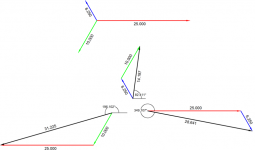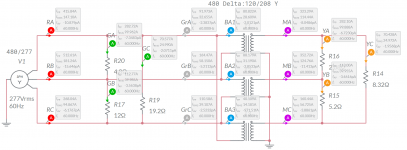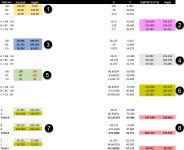Do You Like Ham
Member
- Location
- TX, USA
Hello… I was hoping someone could help confirm my understanding of the theory behind what is happening in a circuit… and hopefully explain it better than I can?
The question comes from this circuit

Which can be summarized as follows:
Table 1

The primary line currents may be determined numerically as shown below.

The cell shading color corresponds to the probe colors in the Multisim circuit. The values are roughly the same as the Irms values (rounding error due to 277/sqrt(3)/4 = 119.94 instead of nominal 120V).
Vectorially, line currents are shown below.

To get the same current on the red probes as Multisim, I found that I need to rotate the angle of the primary loads by -30 degrees. E.g., instead of A, B, and C being at 0, 240, and 120 respectively as on the secondary side in Table 2, they need to be at 330, 210, and 90 as shown in Table 3.
E.g., showing the sum numerically.

(again, blue, green, and red shading correspond to Multisim probes).
And vectorially:

I’ve seen plenty of references describing that when computing the current through delta-wye transformer there is has a phase shift. For example this shows that in balanced system, the primary currents have 30 degree difference with the secondary currents.
However, I’ve not seen any references or documentation on this phenomenon where there are additional loads on the primary side.
Can this essentially be explained by describing the primary and secondary sides having coordinate systems that are rotated from one another by 30 degrees.. thus, when adding loads on the secondary (as in Table 2) they are at 0, 240, 120, whereas on the primary (as in Table 3), they are instead 330, 120, and 90? Is there a better way to describe or explain this?
Maybe they are one-in-the same concept.. but, my initial assumption was, the phase shift is already accounted for as described in this when computing as in Table 2. However, it seems one needs to take additional care to ensure to account for the different “coordinate system” rotation, and I’m struggling a bit to wrap my head around it.
Any additional clarity you can provide would be appreciated!
The question comes from this circuit

Which can be summarized as follows:
- 480/277 distribution system (277 3ph Y voltage source)
- To that, on each phase, I’ve connected what amounts to a 100A, 40A, and 25A load on phases A, B, and C, respectively. These may be verified with the green amp probes.
- Also connected to this is a set of 3 transformers. They are connected delta configuration on the primary, and wye configuration on the secondary. There is a 4:1 turns ratio, thus, producing a 120/208 Y system on the secondary.
- Like the primary, on the secondary I’ve connected what amounts to a 100A, 40A, and 25A load on phases A, B, and C, respectively. These may be verified with the yellow amp probes.
Table 1

The primary line currents may be determined numerically as shown below.

The cell shading color corresponds to the probe colors in the Multisim circuit. The values are roughly the same as the Irms values (rounding error due to 277/sqrt(3)/4 = 119.94 instead of nominal 120V).
Vectorially, line currents are shown below.

To get the same current on the red probes as Multisim, I found that I need to rotate the angle of the primary loads by -30 degrees. E.g., instead of A, B, and C being at 0, 240, and 120 respectively as on the secondary side in Table 2, they need to be at 330, 210, and 90 as shown in Table 3.
E.g., showing the sum numerically.

(again, blue, green, and red shading correspond to Multisim probes).
And vectorially:

I’ve seen plenty of references describing that when computing the current through delta-wye transformer there is has a phase shift. For example this shows that in balanced system, the primary currents have 30 degree difference with the secondary currents.
However, I’ve not seen any references or documentation on this phenomenon where there are additional loads on the primary side.
Can this essentially be explained by describing the primary and secondary sides having coordinate systems that are rotated from one another by 30 degrees.. thus, when adding loads on the secondary (as in Table 2) they are at 0, 240, 120, whereas on the primary (as in Table 3), they are instead 330, 120, and 90? Is there a better way to describe or explain this?
Maybe they are one-in-the same concept.. but, my initial assumption was, the phase shift is already accounted for as described in this when computing as in Table 2. However, it seems one needs to take additional care to ensure to account for the different “coordinate system” rotation, and I’m struggling a bit to wrap my head around it.
Any additional clarity you can provide would be appreciated!



